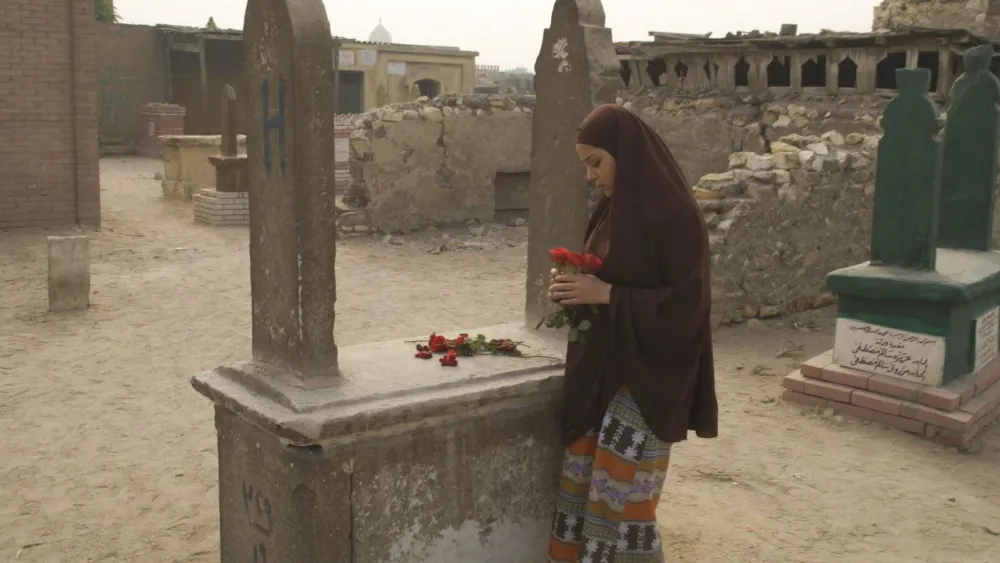
Film Review: ‘Poisonous Roses’
Variety ○ 13 February 2018
The fetid effluence of sewage water is the major leitmotif of Ahmed Fawzi Saleh’s debut feature “Poisonous Roses,” an elliptical drama of two siblings, set within the hellish alleyways of Cairo’s unsavory tannery district. Best viewed as a fictional spinoff from the director’s superb 2010 documentary “Living Skin,” which depicted life in the same (or similar) workshops, the film is a mood piece that fitfully plumbs a sister’s obsessive love for her listless brother, who’s looking to escape Egypt. Atmospheric at the cost of narrative coherence, “Roses” is notable for the way it depicts a quasi-surrealistic netherworld via visually arresting shots of a queasy austerity. Festival programmers clued in to the small but distinctive Egyptian independent scene should come calling, while the French coin involved could translate into additional bookings.
The narrow semi-paved maze of streets in Cairo’s old tannery sector are difficult to square with the modern world: blackened waste pours out of pipes and into public spaces traversed by people and animal carts laden with hides. Each day Taheya (Koky) wends her way through the alleys to bring lunch to her deeply unappreciative brother, Saqr (Ibrahim El-Nagary), working in the district. Saqr’s lack of outward affection for his sister is in inverse proportion to her devotion, which borders on the incestuous. When he tells her he’s met a girl and he wants to go to Italy, Taheya appeals to the local magus (Mahmoud Hemada) for a spell that will keep her brother in Cairo.
On its own, it’s difficult to understand Taheya’s fixation with ensuring her brother remains at home. Sure, the family could use the money he brings in, since she can’t earn much by cleaning public toilets, but Taheya’s almost unnatural love for Saqr, despite his evident indifference, makes little sense as presented in the script. Only when compared with the film’s source material, Ahmed Zaghloul Al-sheety’s influential 1990 novel “Poisonous Roses for Saqr,” with its clear allusion to Taheya as a kind of modern-day Isis, does the quasi-incestuous, over-protective nature of the brother-sister relationship make sense.
Yet what’s the film trying to say with this? If it’s meant as a metaphor for today’s Egypt — and given the nature of the country’s dictatorship, metaphor is the only way any critique can be formulated — the message remains abstruse, though one could assign concrete values to these hypothetical allegories and thereby get entangled in any number of conjectured allusions. For example, what are we to make of the siblings’ mother (Safaa El-Toukhy), whose total lack of interest in Taheya could make the viewer presume she’s a step-mother rather than a biological relation, though that would render moot the whole Isis-Osiris parallel.
Far better to focus on the film’s genuine strengths, which lie in the visuals. Saleh and his cinematographer, Maged Nader, have an accomplished understanding of framing and pattern, making the medieval-seeming tanneries and the glue factory where Saqr later works at once repellent and captivating, without falling into the trap of exoticizing poverty. Taheya’s abaya-clad figure casually negotiating the squalid lanes that act as sluices for run-off chemicals forms a striking composition, her dark figure contrasted with the sand-colored buildings. Blue- and orange-dyed hides stretched and drying in the sun act as an open-air abstract tapestry. Accompanying these images is the inescapable sensation of the stench, and the thought that the actors, unaccustomed to the smell (unlike those who work there), must have exhibited heroic fortitude to endure these conditions.